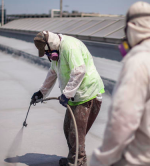Fire tests are one of the most important system tests for roof coatings, and it is essential when specifying and applying a coating over an existing roof in a maintenance or repair setting to ensure the roof system’s fire rating is not negatively affected.
TEST METHODS FOR FIRE TESTS
The International Building Code (IBC), first published in 2000, brought together several regional codes into one central, national code and facilitated the acceleration of code adoptions across the U.S. Today, most of the U.S. follows a statewide adoption process for the IBC for Roof Assemblies and Rooftop Structures; some areas do not, which can make code enforcement tricky. Some areas still follow local adoption and may refer to older versions of the code instead of the most current 2012 IBC.
According to the most recent IBC, roof assemblies and coverings are divided into classes A, B, C or “Nonclassified” and are tested in accordance with UL 790 or ASTM E 108. These tests measure the spread of flame, recording whether the material you put on the roof will cause the flame to spread too far on the roof. The UL 790 inaugurated modern fire tests about 100 years ago and, as such, incorporates a century of data and history about roof coatings that may broaden the reach of what certifications the test provides.
“Many see UL 790 as the preferred fire test,” notes Steve Heinje, technical service manager with Quest Construction Products LLC. “It is interesting to note the ASTM E 108 test is deemed by the code requirements an equivalent test.” The ASTM E 108 is a consensus version of UL 790 and can be run by any qualified and accredited test laboratory. Many test laboratories, such as FM Approvals, conduct testing using ASTM E 108.
COMPONENTS OF FIRE TESTING
The roof coating is just one component in the fire rating of a roof assembly; other components include slope, the coating substrate, whether the roof deck is combustible and whether the roof is insulated. These factors, taken together, will determine the roof system’s fire rating.
SLOPE
Although there are exceptions, most fire ratings are done for slopes of under 3/4 inch for commercial roofs, and coatings tend to be recommended for application to a roof with 2 inches or less slope. Slope is an important factor to consider because special coatings may be needed for high slope transitions.
SUBSTRATE
The substrate or membrane type is another vital component of fire testing because the substrate to which the coating is applied could affect the flammability of the roof system. When coating over an existing roof, one should note what existing roofing substrate is being coated over—whether it’s BUR, mod bit, concrete, metal, asphalt or another type of substrate.
COMBUSTIBLE VS. NON-COMBUSTIBLE ROOF DECK
Most coatings are tested over noncombustible decks, but additional and challenging tests are required for the use of combustible decks. It is much more difficult to achieve a Class A rating when covering a wood deck.
INSULATION
Again, it is important to note the materials of the existing roof being coated because these components can affect the flammability of the roof system. Polymeric insulations often reduce the allowable slope for a given system.
PROPER APPLICATION OF THE ROOF COATING
Another significant consideration is that the coating is applied at the appropriate thickness and rate.
“One big thing out of the coating manufacturer’s control is that the applicator uses the recommended or test-required thickness and/or rate at the point of application,” points out Skip Leonard, technical services director with Henry Co. Proper application encompasses parameters, such as the final dry-film thickness, the use of granules or gravel, use of reinforcements and even the number of coats. Accounting for these details is an integral part of installing a rated system.
Once assembled, the roof covering will be granted a Class A, B or C rating by approved testing agencies, typically through UL 790 or ASTM E 108, depending on how effective the roof proves to be in terms of fire resistance. Rated coating solutions exist for just about any existing roof system recover or coating application and often can achieve a Class A rating.
Learn More
Visit the Roof Coatings Manufacturers Association website to locate a roof-coating manufacturer who can help you choose a roof coating most appropriate for your roof system. For more information about roof-coating fire ratings, check out FM Approval’s RoofNav online database for up-to-date roofing-related information or the UL Online Certifications Directory.




I want to have my roof coated. It makes sense that fire tests would be important to carry out for it! I’ll make sure that it’s tested on a combustible deck. That would definitely prove it’s benefit!